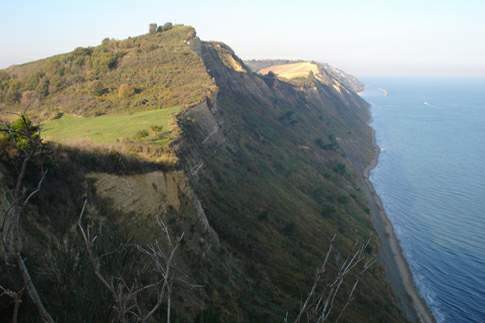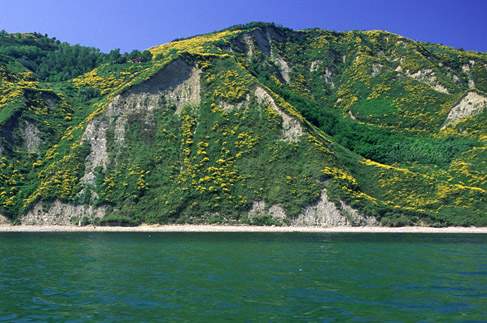
Monte San Bartolo Regional Natural Park
This post is also available in:
 Italiano (Italian)
Italiano (Italian)
Established in 1994, this park covers about 4.000 acres in the province of Pesaro Urbino, along the coastal area and the hilly ridge, between the municipalities of Pesaro and Gabicce Mare.
Its territory has a rather heterogeneous environmental texture, with very different plant associations, also based on human activities; cliffs and caves are present as well, otherwise quite scarce rare in the rest of the region. The park has two main areas: one between the “Strada Statale n.16 Adriatica” and the “Strada Provinciale n.44 Panoramica”, and the other stretching between the Provincial “Panoramica” road and the coast.
The first area, which represents about 60% of the park, is made of an agricultural landscape, with arable land (autumn-winter cereals) alternating with forage crops (Lucerne – Medicago sativa), surrounded by tree and shrub hedges, vineyards, and some olive groves; it also features several quaint villages, villas and castles.
The second area coincides, for the most part, with the territory of the Floristic Area of the cliff between Gabicce and Pesaro; the cliff and the beach are natural areas of great value, due to their geomorphological, vegetational and faunal feature of great importance.
Fauna
Given the agricultural vocation of most of the park, the presence of medium-large mammals was always quite scarce until the 1990s; then, roe deers arrived in San Bartolo and eventually found it perfect for their own survival, mostly thanks to crops and groves.
Among the other faunal species in the park, there are foxes (which can also be seen on the beaches, feeding on marine organisms), badgers, porcupines, weasels, hares, dormice, several species of reptiles, amphibians, and birds during their migrations.
Flora
It is very rich and includes rare species, some typical of the cliff environment. However, the original woods have disappeared or shrunk into small impoverished strips, due to some invasive woody species such as brambles, black locust, and ailanthus.
Quite rare and thriving in less crowded areas, there are native trees and shrubs, including Turkey oak (Quercus cerris), hornbeam (Carpinus betulus), hazelnut (Corylus avellana), Hungarian maples (Acer obtusatum), daphne (Daphne laureola), and Erica arborea, typical of mesophilic woods.
In some areas, such as near Santa Marina Alta and Fiorenzuola di Focara, conifer woods (Pinus nigra and Pinus halepensis) can be found, planted in the XX century to counteract the hydrogeological instability.
Worthy of note is also the presence of Clematis viticella, not very common throughout the region, Clematis flammula, a thermophilic species more common elsewhere, and the mastic tree (Pistacia lentiscus), a relic of an almost disappeared Mediterranean vegetation.
On the hard and compact arenaceous rocks, there are deciduous oaks such as the downy oak (Quercus pubescens), while where the soil is more humid, there are some groves of white poplars (Populus alba) and field elms (Ulmus minor).
Flowers are just as abundant; in arid grassy places, on steep slopes or at the edges of cultivated and uncultivated fields, we can find, in addition to other fairly homogeneous and common species, rare herbaceous plants (Geranium tuberosum, Tulipa agenensis, Tulipa clusiana, Tulipa sylvestris, Urtica urens, Orobanche picridis, Vicia lutea, Fumaria parviflora), many orchids such as Anacamptys pyramidalis, Orchis coriophora, Spiranthes spiralis, Orchis tridentata, Ophrys apifera, as well as thermophilic and xerophilous species such as Aster linaliyym, F Ononis reclinata, Silene nocturna, Valerianella coronata, and Valerianella muricata.
In subruderal environments, in addition to the many nitrophilous and invasive species, there is also Veronica cymbalaria, extremely rare throughout the region.
On the reliefs, in the sandy outcrops, there are large broom bushes, along with common juniper (Juniperus communis), Colutea arborescens, elmleaf blackberry (Rubus ulmifolius), common dogwood (Cornus sanguinea), dog roses, blackthorn (Prunus spinosa), hawthorn (Crateagus oxyacantha), Etruscan honeysuckle (Lonicera etrusca), and, in some areas, invasive bushes.
At the foot of the cliffs, in the steeper parts, few plants can grow, including Lotus maritimus, Crithmum maritimum and, among the rocks of the cliffs, Aristolochia clematitis, and Solanum dulcamara.
In the small stretches of the beach, rare psammophilous species include Eryngium maritimum, Cakile marittima, Salsola tragus subsp. pontica, Limbarda crithmoides, and Calystegia soldanella.
In Flaminia Bay, despite the strong tourist presence, nitrophilous and ruderal species survive in the oldest and most consolidated areas of the beach, as well as rare species such as Hypochoeris radicata, and Carex divisa.
Other Information
Among the architectural beauties in the park, there’s the Rocca di Gradara and its fortified village, one of the best-preserved and imposing medieval structures in Italy, as well as Villa Caprile and Villa Imperiale, with their wonderful gardens
Unfortunately, a big fire on 5 August 2017, destroyed 350 acres of land between the municipalities of Fiorenzuola di Focara and Casteldimezzo.
This post is also available in:
 Italiano (Italian)
Italiano (Italian)
Contatti
Sede Ente Parco San Bartolo Viale Varsavia - 61121 Pesaro(PU)
+39 0721 268426
comunicazione@parcosanbartolo.it



